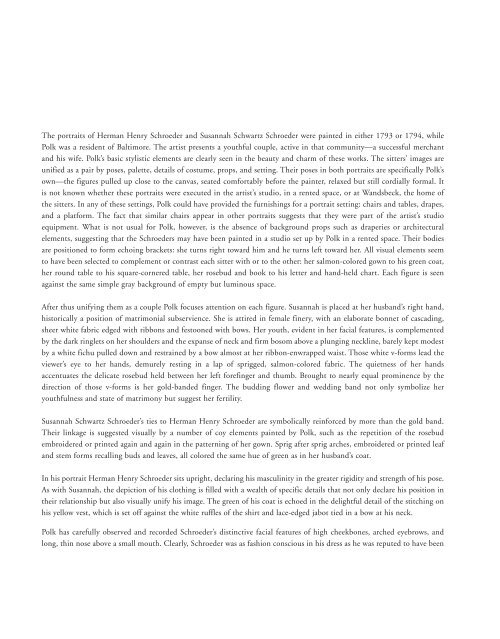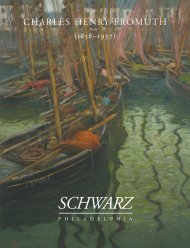pdf - Schwarz Gallery
pdf - Schwarz Gallery
pdf - Schwarz Gallery
Create successful ePaper yourself
Turn your PDF publications into a flip-book with our unique Google optimized e-Paper software.
The portraits of Herman Henry Schroeder and Susannah Schwartz Schroeder were painted in either 1793 or 1794, while<br />
Polk was a resident of Baltimore. The artist presents a youthful couple, active in that community—a successful merchant<br />
and his wife. Polk’s basic stylistic elements are clearly seen in the beauty and charm of these works. The sitters’ images are<br />
unified as a pair by poses, palette, details of costume, props, and setting. Their poses in both portraits are specifically Polk’s<br />
own—the figures pulled up close to the canvas, seated comfortably before the painter, relaxed but still cordially formal. It<br />
is not known whether these portraits were executed in the artist’s studio, in a rented space, or at Wandsbeck, the home of<br />
the sitters. In any of these settings, Polk could have provided the furnishings for a portrait setting: chairs and tables, drapes,<br />
and a platform. The fact that similar chairs appear in other portraits suggests that they were part of the artist’s studio<br />
equipment. What is not usual for Polk, however, is the absence of background props such as draperies or architectural<br />
elements, suggesting that the Schroeders may have been painted in a studio set up by Polk in a rented space. Their bodies<br />
are positioned to form echoing brackets: she turns right toward him and he turns left toward her. All visual elements seem<br />
to have been selected to complement or contrast each sitter with or to the other: her salmon-colored gown to his green coat,<br />
her round table to his square-cornered table, her rosebud and book to his letter and hand-held chart. Each figure is seen<br />
against the same simple gray background of empty but luminous space.<br />
After thus unifying them as a couple Polk focuses attention on each figure. Susannah is placed at her husband’s right hand,<br />
historically a position of matrimonial subservience. She is attired in female finery, with an elaborate bonnet of cascading,<br />
sheer white fabric edged with ribbons and festooned with bows. Her youth, evident in her facial features, is complemented<br />
by the dark ringlets on her shoulders and the expanse of neck and firm bosom above a plunging neckline, barely kept modest<br />
by a white fichu pulled down and restrained by a bow almost at her ribbon-enwrapped waist. Those white v-forms lead the<br />
viewer’s eye to her hands, demurely resting in a lap of sprigged, salmon-colored fabric. The quietness of her hands<br />
accentuates the delicate rosebud held between her left forefinger and thumb. Brought to nearly equal prominence by the<br />
direction of those v-forms is her gold-banded finger. The budding flower and wedding band not only symbolize her<br />
youthfulness and state of matrimony but suggest her fertility.<br />
Susannah Schwartz Schroeder’s ties to Herman Henry Schroeder are symbolically reinforced by more than the gold band.<br />
Their linkage is suggested visually by a number of coy elements painted by Polk, such as the repetition of the rosebud<br />
embroidered or printed again and again in the patterning of her gown. Sprig after sprig arches, embroidered or printed leaf<br />
and stem forms recalling buds and leaves, all colored the same hue of green as in her husband’s coat.<br />
In his portrait Herman Henry Schroeder sits upright, declaring his masculinity in the greater rigidity and strength of his pose.<br />
As with Susannah, the depiction of his clothing is filled with a wealth of specific details that not only declare his position in<br />
their relationship but also visually unify his image. The green of his coat is echoed in the delightful detail of the stitching on<br />
his yellow vest, which is set off against the white ruffles of the shirt and lace-edged jabot tied in a bow at his neck.<br />
Polk has carefully observed and recorded Schroeder’s distinctive facial features of high cheekbones, arched eyebrows, and<br />
long, thin nose above a small mouth. Clearly, Schroeder was as fashion conscious in his dress as he was reputed to have been



